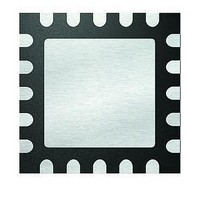MCP4461T-103E/ML Microchip Technology, MCP4461T-103E/ML Datasheet - Page 64

MCP4461T-103E/ML
Manufacturer Part Number
MCP4461T-103E/ML
Description
IC DGTL POT 257TAPS 10K 20QFN
Manufacturer
Microchip Technology
Datasheet
1.MCP4441-103EML.pdf
(100 pages)
Specifications of MCP4461T-103E/ML
Package / Case
20-VFQFN Exposed Pad
Temperature Coefficient
150 ppm/°C Typical
Taps
257
Resistance (ohms)
10K
Number Of Circuits
4
Memory Type
Non-Volatile
Interface
I²C, 2-Wire Serial
Voltage - Supply
2.7 V ~ 5.5 V
Operating Temperature
-40°C ~ 125°C
Mounting Type
Surface Mount
Number Of Pots
Quad
Taps Per Pot
257
Resistance
10 KOhms
Wiper Memory
Non Volatile
Buffered Wiper
Buffered
Digital Interface
I2C
Operating Supply Voltage
2.7 V to 5.5 V
Supply Current
600 uA
Maximum Operating Temperature
+ 125 C
Minimum Operating Temperature
- 40 C
Description/function
Quad I2C Digital POT with Nonvolatile Memory
Mounting Style
SMD/SMT
Supply Voltage (max)
5.5 V
Supply Voltage (min)
2.7 V
Lead Free Status / RoHS Status
Lead free / RoHS Compliant
Available stocks
Company
Part Number
Manufacturer
Quantity
Price
Part Number:
MCP4461T-103E/ML
Manufacturer:
MICROCHIP/微芯
Quantity:
20 000
MCP444X/446X
7.4
The Write Command can be issued to both the Volatile
and Nonvolatile memory locations. The format of the
command, see
Byte, an A bit, the MCP44XX Command Byte, an A bit,
the MCP44XX Data Byte, an A bit, and a Stop (or
Restart) condition. The MCP44XX generates the A / A
bits.
A Write command to a Volatile memory location
changes that location after a properly formatted Write
Command and the A / A clock have been received.
A Write command to a Nonvolatile memory location will
only start a write cycle after a properly formatted Write
Command have been received and the Stop condition
has occurred.
7.4.1
For volatile memory locations, data is written to the
MCP44XX after every byte transfer (during the
Acknowledge). If a Stop or Restart condition is
generated during a data transfer (before the A), the
data will not be written to the MCP44XX. After the A bit,
the master can initiate the next sequence with a Stop or
Restart condition.
Refer to
7.4.2
The sequence to write to a single nonvolatile memory
location is the same as a single write to volatile memory
with the exception that the EEPROM write cycle (t
started after a properly formatted command, including
the Stop bit, is received. After the Stop condition
occurs, the serial interface may immediately be
re-enabled by initiating a Start condition.
During an EEPROM write cycle, access to the volatile
memory (addresses 00h, 01h, 04h, 05h, 06h, 07h, and
0Ah) is allowed when using the appropriate command
sequence.
memory are ignored until the EEPROM write cycle (t
completes. This allows the Host Controller to operate
on the Volatile Wiper registers, the TCON register, and
to Read the Status Register. The EEWA bit in the
Status register indicates the status of an EEPROM
Write Cycle.
Once a write command to a Nonvolatile memory
location has been received, no other commands should
be received before the Stop condition occurs.
Figure 7-2
DS22265A-page 64
Note:
Figure 7-2
Write Data
Normal and High Voltage
shows the waveform for a single write.
Writes to certain memory locations will be
dependant on the state of the WiperLock
Technology bits and the Write Protect bit.
SINGLE WRITE TO VOLATILE
MEMORY
SINGLE WRITE TO NONVOLATILE
MEMORY
Commands
Figure
for the byte write sequence.
7-2, includes the I
that
address
2
nonvolatile
C Control
wc
) is
wc
)
7.4.3
A continuous write mode of operation is possible when
writing to the volatile memory registers (address 00h,
01h, 04h, 06h, 07h, and 0Ah). This continuous write
mode allows writes without a Stop or Restart condition
or repeated transmissions of the I
Figure 7-3
writes. The writes do not need to be to the same volatile
memory address. The sequence ends with the master
sending a STOP or RESTART condition.
7.4.4
If a continuous write is attempted on Nonvolatile
memory, the missing Stop condition will cause the
command to be an error condition (A). A Start bit is
required to reset the command state machine.
7.4.5
The High Voltage Command (HVC) signal is
multiplexed with Address 0 (A0) and is used to indicate
that the command, or sequence of commands, are in
the High Voltage operational state. High Voltage
commands allow the device’s WiperLock Technology
and write protect features to be enabled and disabled.
The HVC pin has an internal resistor connection to the
MCP44XXs internal V
shows the sequence for three continuous
CONTINUOUS WRITES TO
VOLATILE MEMORY
CONTINUOUS WRITES TO
NONVOLATILE MEMORY
THE HIGH VOLTAGE COMMAND
(HVC) SIGNAL
DD
© 2010 Microchip Technology Inc.
signal.
2
C Control Byte.
















